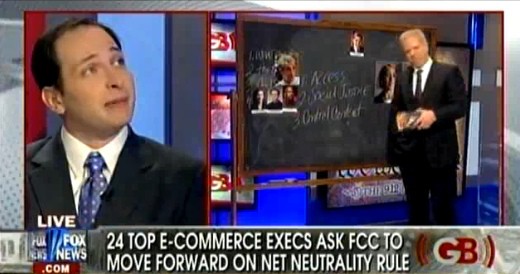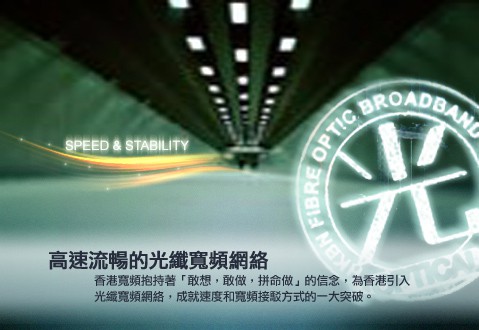
Phil Kerpen (left) waits his turn while Glenn Beck explains the Marxism connection in Net Neutrality
Glenn Beck, who is America’s biggest argument for mental health parity in health care reform, has turned his paranoid ravings to the subject of Net Neutrality, suggesting the whole concept is one giant government conspiracy to take over the Internet. To prove the point, he brings on Phil Kerpen, policy director and master astroturfer for “Americans for Prosperity,” which should really be called “Telecom Companies for Prosperity.”
Glenn Beck believes there is a conspiracy by Obama Administration officials, working with “Marxists and Maoists,” to secretly gain control of the Internet through the implementation of Net Neutrality, and to prove it, he brings on a guy whose paycheck depends on the corporate contributions from big telecommunications companies that want him to pretend he represents actual consumers. The real conspiracy was sitting just six feet away from Glenn, but he missed it because he was too busy rearranging pictures of Mao Tse-Tung and others on his magnetized chalkboard.
Drawing chalk lines and stacking and re-stacking pictures like some sort of deranged episode of The Hollywood Squares doesn’t actually prove a conspiracy, but I’ll take Mao Tse-Tung in the center square to block!
In a remarkably fact free ten minutes, Glenn’s photo album of the guilty got star billing, as he labeled those who personally crossed swords with Beck or Fox News as “Marxists.” Van Jones, who founded Color of Change, the organization that coordinated an effort to strip Beck of virtually all of his mainstream paid advertisers after Beck accused President Obama of being racist against white America is there. Rahm Emanuel and Anita Dunn, both of whom referred to Fox News as an arm of the Republican Party are there (Emanuel “is just evil, not a Marxist” according to Beck, while Dunn is a “Maoist.”) Robert McChesney, who co-founded Free Press, one of many public interest groups fighting for Net Neutrality is there as well. He’s the ‘real string puller and master conspirator’ here, according to Beck and Kerpen.
At times, this theater of the absurd left Kerpen with an odd look on his face, reduced to simply looking up at Beck, who spent large amounts of two segments on the all-important issue of moving and labeling pictures of his personal enemies around like a 14 year old throwing a temper tantrum. It’s hard to argue Americans for Prosperity represents the sane position on Net Neutrality after Kerpen’s ten minute Beck Affirmation Session.
[flv width=”640″ height=”480″]http://www.phillipdampier.com/video/Glenn Beck Ravings of Net Neutrality Part One 10-20-09.flv[/flv]
Part one of Glenn Beck’s rant on Net Neutrality with Americans for Prosperity’s Phil Kerpen on October 20th (6 Minutes)
When dealing with people not entirely there, sometimes it is safer to just humor them while you seek a graceful exit. But Kerpen played along with Beck’s label gun, and as we’ve seen all year, co-opted the paranoia among some conservatives that Net Neutrality, the Fairness Doctrine, and President Barack Obama are all conspiring to silence Glenn, right wing talk radio, and sooner or later all dissent.
Beck opens the discussion by fundamentally misunderstanding the very definition of Net Neutrality.
“Net neutrality. This is that everybody should have free Internet, right?,” Beck asks Kerpen.
“Well, essentially. You know, they dress it up the way they dress up a lot of their things. They turn it upside-down by saying that evil corporations, phone and cable corporations are going to block what we can do block or we can say,” Kerpen responds.
In fact, Net Neutrality has nothing to do with giving away free access to the Internet. It is about preserving the free exchange of ideas that would allow Glenn, and anyone else, to talk about whatever they want online without fear a broadband provider would interfere with their content, slow access to it, block it, or charge extra to make sure it gets through to people at reasonable speeds.
Beck tried to conflate Net Neutrality with a government plan to give away access to everyone at taxpayer expense.
“I don’t remember anybody saying in the 1930s that everybody had a right to radio and we gave away free radios for the government. And I don’t remember anybody in the ’50s everybody deserved a free television, but that’s where we’re headed now. So that neutrality – I want to get to that later on in the week,” Beck said.
Perhaps Beck will educate himself on Net Neutrality by that time.
Kerpen knows better, but he’s paid to distort the issue. Stop the Cap! consumers encountered Americans for Prosperity in North Carolina this past summer who were duped to show up to support state measures restricting municipal broadband projects in the state. They thought they were there to support a-la-carte cable programming options and to oppose Obama Administration “emergency powers” to control the Internet. Upon learning the true nature of the legislation at hand, a number of them ended up on our side. They hate big telephone and cable monopolies too.
Americans for Prosperity is largely funded by corporate interests, which makes it unsurprising they would echo their talking points.
Kerpen’s fear factory that Net Neutrality represents a way for government to demand balance on websites is laughable, but then we know better. For a crowd that already believes in the basic construct of Glenn Beck’s world view, it’s entirely believable. That’s a shame, because it is Net Neutrality that ultimately will protect their access to Glenn’s online content without blockades or extortionist pricing from broadband providers.
[flv width=”640″ height=”480″]http://www.phillipdampier.com/video/Glenn Beck Ravings of Net Neutrality Part Two 10-20-09.flv[/flv]
Part two of Glenn Beck’s rant on Net Neutrality with Americans for Prosperity’s Phil Kerpen on October 20th (5 Minutes)


 Subscribe
Subscribe



